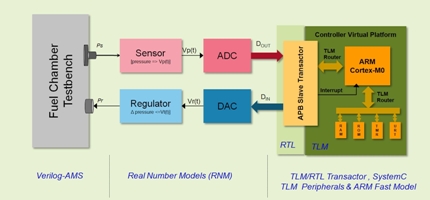What do we mean by “the internet of things” and why is it becoming so important to software design, writes Frank Schirrmeister of Cadence Design Systems
As we approach the Embedded World exhibition and conference in Nuremberg next week, something feels fundamentally different in the industry.
In the past the flashy media devices enabled by cool operating systems like Android, Windows 8 Mobile and iOS were at centre stage and got the full attention of software developers. And we will certainly see those as well this year in 2013, but there is new trend driving software as well.
The message of a company such as ARM is promising that “attendees will gain insight into the next generation of low-power, high-performance embedded devices that are powering the world around us and enabling the internet of things.”
The term “internet of things” has been used for a while, but this year its effect has a more profound impact.
50 billion internet connected devices
For example this will apparently include cattle equipped with wireless sensors so that a sick or pregnant cow will “send” a message to the farmer. Each cow transmits 200Mbyte of data per year.
The consultancy firm Casaleggio Associati describes the evolution of the internet of things from “the world as an index” through “taking the world online”, “taking control of the world”, “let the things talk to each other” to “let things become intelligent.”
The concept of the “internet of things” can cover a wide range of applications – buildings, energy, consumer and home, healthcare and life science, industrial, transportation, retail, security and public safety, IT and networks – from service sectors to application groups, locations and devices.
Hardware/software design
The common thread across all of this is the set of devices to be connected and the connections to the environment itself. And it requires changes in the development flows, a transition that has already started.
The hardware and software of the connected devices needs to be validated within their environment.
As a result, from a development tool perspective, the interaction of software with the analogue and mixed-signal world, as well as the environment the devices reside in, gains much more importance.
While the “heavy duty” embedded software development for operating systems is still at the forefront and requires as early as possible access to representations of the hardware, a new category of software for less complex processor cores creates a new set of requirements on development flows.

For example, software on a virtual platform for an ARM Cortex-M0 based microcontroller can be used to control the regulator for a fuel pump module and injector based on the inputs it gets from the pressure sensors. Analogue elements are part of the developemnt environment and need to be modelled as such.
Mixed level development environments are intended to enable software development in the context of the environment the connected devices reside in.
This includes virtual platforms for automotive driver assist systems and FPGA-based prototypes for embedded system development. Both are connected to the system environment and connected to simulation hosts to allow efficient balance of system-level transaction-level code with RTL implementation, and also emulation with accelerated Ethernet intellectual property for automotive.
In addition to the pure embedded world, development environments have to take into account the software within the environment infrastructure.
The 200Mbyte of data produced per year per cow as well as data created in automotive sensors are received in the environment and lead to the phrase “big data analytics.”
Imagine the sensors of the car being connected and providing data on street conditions. Once enough cars do that, it will allow guidance and warning to other cars and drivers approaching the same location, enabling a truly smart network and increasing safety for all participants in transportation.
Technology exhibitions such as Embedded World in Nuremberg can now give us the flavour of the device side of the “internet of things” and the associated development challenges as the device and its environment have to be considered together.





